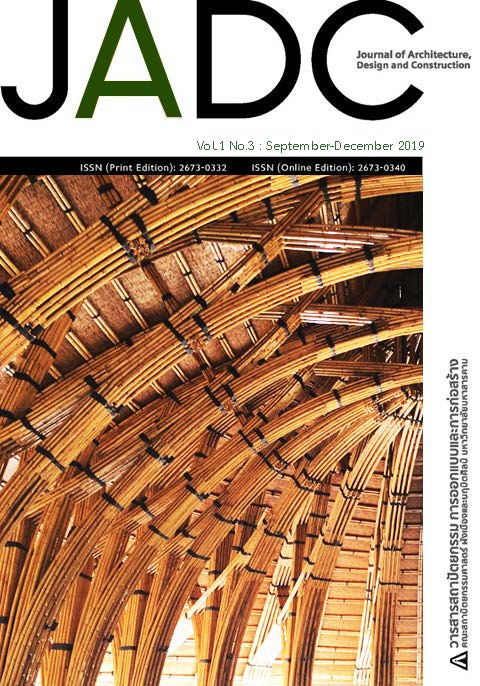Construction and Embodied Energy Rammed Building
Main Article Content
Abstract
Research Objectives are soil properties testing by experiment was performed using two types of soil: clay and red soil that mixed with husk and straw. And Making the table to help design the Rammed Earth wall. That to Construction and summarize procedures and techniques. Calculation the heat transfers from the building. Compare with other wall materials.
The research found the compressive strength of clay is higher than that of clay soils. The compressive strength days of clay 28th clay soil is 15.02 ksc, whereas red soil is 3.71 ksc. The Tool was developed is tables that can design a building is two-story, wall thickness are 40-60 cm. And height of 2.5-3.50 meters. The room size is 3.00-4.50 meters. Red soil is used to build the rammed earth building, because of that near the construction site. The compressive strength used in the design was 1.39 ksc. The building had two types walls with area of 171.00 square meters. For Rammed construction use labors than general construction, because of use that labors for compaction a wall, but use less skill labor. The total heat transfer of OTTV is 22.01 Watt/hour. The cumulative energy value of wall in the rammed building is 11,285.07 kw, which is less than the brick wall and cement block wall.
Downloads
Article Details
The articles published in the Journal of Architecture, Design and Construction are the intellectual property of the Faculty of Architecture, Urban Design and Creative Arts, Mahasarakham University.
References
กาญจน์กรอง สุอังคะ. (2557). รายงานวิจัย การประเมินด้านการประหยัดพลังงานของการออกแบบและการใช้วัสดุก่อสร้างเพื่อการประหยัดพลังงานของบ้านพักอาศัย. นครราชสีมา: มหาวิทยาลัยเทคโนโลยีสุรนารี.
กรมพัฒนาและส่งเสริมพลังงาน กระทรวงวิทยาศาสตร์ เทคโนโลยีและสิ่งแวดล้อม. (2557). รายงานพลังงานของประเทศไทยปี 2542. [ออนไลน์]. ได้จาก: https://www.dedp.go.th, [สืบค้นเมื่อ วันที่ 5 พฤษภาคม 2559].
กรมโยธาและผังเมือง กระทรวงมหาดไทย. กฎหมายด้านโยธาและผังเมือง. พระราชบัญญัติควบคุมอาคาร พ.ศ. 2522. [ออนไลน์]. ได้จาก: https:// https://www.dpt.go.th/th, [สืบค้นเมื่อ วันที่ 20 สิงหาคม 2560].
พิมลมาศ วรรณคนาพล. (2544). ดัชนีพลังงานสะสมรวมของอาคารและวัสดุก่อสรางอาคารในช่วงก่อสร้างและรื้อถอน. ปริญญาสถาปัตยกรรมศาสตรมหาบัณฑิต สาขาสถาปัตยกรรม คณะสถาปัตยกรรมศาสตร์ จุฬาลงกรณ์มหาวิทยาลัย.
Bui, Trung, Quoc-Bao, Maximilien. (2014). Failure of rammed earth walls: From observations to quantifications. Construction and Building Materials, Vol. 51, Issue 15, (pp. 295-302).
Bui, Q.B., Morel, J.C., Venkatarama Reddy, B.v. and Ghayad. (2009). Durability of rammed earth walls exposed for 20 years to natural weathering. Building and Environment, Vol. 44, Issue 5, (pp. 912-919).
Ciancio, Daniela & Beckett, Christopher. (2013). Rammed earth: An overview of a sustainable construction material. Sustainable Construction Materials and Technologies: Proceedings of the 3rd International conference, (pp. 193-198). West Sussex, UK: IMP.
Gerald W. May. (1984). Structural Engineering for Earth Buildings, Adobe and Rammed Earth Buildings: Design and Construction. Tucson: University of Arizona Press, 984. London, Routledge.
Hall M & Djerbib Y. (2004). Rammed Earth Sample Production. Construction and Building Material, Vol. 18, Issue 4, (pp. 281-286).
Jayasinghe, c. and Kamaladasa, N. (2007). Compressive strength characteristics of cement stabilized rammed earth walls. Construction and Building Materials, Vol. 21, Issue 11, (pp. 1971-1976).
Matthew Hall and Youcef Djerbib. (2004). Rammed earth sample production: context, recommendations and consistency. Construction and Building Materials, Vol. 18, Issue 4, (pp. 281-286).
Malhotra, Mini. (2018). EARTHSHACK Showcasing Rammed Earth Construction. Rammed Earth Solar Home. [Online]. Retrieved from https://www.rammedearthhomes.com/technical.html. [accessed 30 May 2015].
McHenry, Paul Graham. (1984). Adobe and Rammed Earth Buildings: Design And Construction. Tucson: University of Arizona.
Miloslave Bagona, Dusan Katunsky. (2010). Embodied Energy of Stabilized Rammed Earth. Energy and Buildings, Vol. 42, Issue 3, (pp. 380-385).
Odum, Howard T., Brown Mark T. and Brandt-Williams, Sherry. (2001). Handbook of Emergy Evaluation. A compendium of Data for Emergy Center for Environmental Policy Environmental Engineering Sciences, University of Florida.
Richard Burt. (2005). Showcasing Rammed Earth Construction. USA. Texas A&M University.


